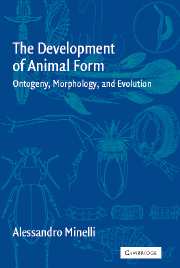Book contents
- Frontmatter
- Contents
- Preface
- Acknowledgements
- 1 The Nature of Development
- 2 Everything Begun to the Service of Development: Cellular Darwinism and the Origin of Animal Form
- 3 Development: Generic to Genetic
- 4 Periodisation
- 5 Body Regions: Their Boundaries and Complexity
- 6 Differentiation and Patterning
- 7 Size Factors
- 8 Axes and Symmetries
- 9 Segments
- 10 Evo-devo Perspectives on Homology
- Summary and Conclusions
- References
- Index
10 - Evo-devo Perspectives on Homology
Published online by Cambridge University Press: 10 August 2009
- Frontmatter
- Contents
- Preface
- Acknowledgements
- 1 The Nature of Development
- 2 Everything Begun to the Service of Development: Cellular Darwinism and the Origin of Animal Form
- 3 Development: Generic to Genetic
- 4 Periodisation
- 5 Body Regions: Their Boundaries and Complexity
- 6 Differentiation and Patterning
- 7 Size Factors
- 8 Axes and Symmetries
- 9 Segments
- 10 Evo-devo Perspectives on Homology
- Summary and Conclusions
- References
- Index
Summary
Cells may have different characters now because they were in different situations in the past. They are like identical twins reared apart; they remember their separate experiences.
J.H. Lewis and L. Wolpert 1976: 467The initial progenitor field is transformed into a mosaic of regulatory subdomains, and, remarkably, these prefigure the morphological pieces of the body part.
E.H. Davidson 2001: 110Concepts and Interpretations
From a structuralist perspective, Müller and Newman (1999) have developed the interesting argument that homologous structures, in so far as they are integrated as fundamental parts of a given body plan, become ‘attractors of morphological design’, a kind of backbone to which further elements of body design may be added.
Hierarchies and Beyond
A hierarchical frame of mind is taken for granted in nearly all approaches to homology. Analysis in terms of hierarchies of structural parts or functional subsystems has been a common strategy in the study of complex systems since the dawn of modern science (Bechtel and Richardson 1993, Zawidzki 1998). However, as forcefully argued by Kauffman (1993), with biological systems this is not the most satisfactory strategy. Ahl and Allen (1996) define a system as hierarchical if it is composed of stable, observable subunits unified by a superordinate relation. It would be fortunate if the features we try to compare were always stable and unified by a superordinate relation. I suspect, however, that stable and hierarchically unified features would make the world much duller and less interesting than the real biological world.
- Type
- Chapter
- Information
- The Development of Animal FormOntogeny, Morphology, and Evolution, pp. 222 - 249Publisher: Cambridge University PressPrint publication year: 2003
- 1
- Cited by



